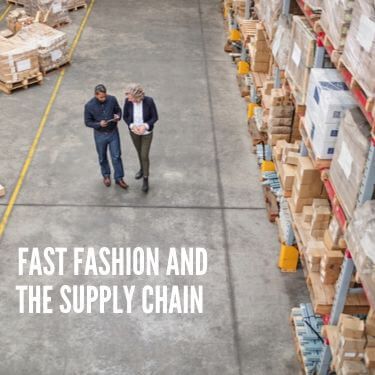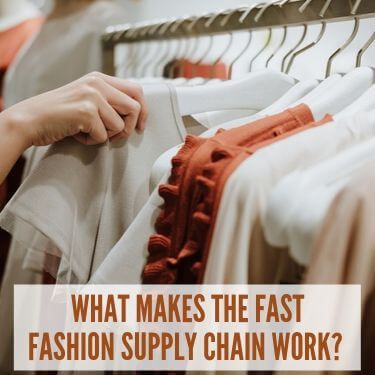
 Copy URL to Clipboard
Copy URL to Clipboard
Fast fashion is a dominating trend in the retail supply chain. Fast fashion needs to get into stores and online quickly. When your business model moves quickly, your supply chain needs to move quickly, too.
Sometimes called “fashion on demand,” fast fashion refers to clothing and home items that have vertical supply chains and are designed for speed to market. Learn more about fast fashion, the supply chain and how R+L Global Logistics’ distribution and fulfillment process can help your business stay in style.
Table of Contents

Fast fashion can be described as trendy clothing that is inspired by looks from designer’s catwalks and celebrity culture. It is dictated by fashion trends and can be affordable to consumers.
Some might say that fast fashion rules retail today. One thing that makes fast fashion unique is that collections are changed out quickly, especially when compared to traditional fashion business models. Traditional fashion business models operate on a 2-3 season cycle per calendar year. New merchandise is added to a store’s collection every few months. When it comes to fast fashion, things practically move at the speed of light. Fast fashion operates on a 12-month (or more) seasonal calendar. New collections are added monthly or even weekly to stores. Some buyers consider fast fashion disposable clothing because it moves so quickly.
It’s easy to spot a fast fashion brand. If a clothes fashion retailer...
… it might be a fast fashion company. Examples of fast fashion retailers include H&M, Zara, Forever 21, Charlotte Russe, Old Navy and many others. Many department stores also participate in fast fashion practices, in addition to housing traditional retail models.
Fast fashion might be the answer to most of retails woes. As traditional retailers like Sears are shuttering stores and shopping malls are closing, fast fashion offers a solution. It is designed to boost sales, increase traffic into brick-and-mortar and online storefronts, and grow profit margins. Fast fashion is the new normal, especially for younger consumers.
It’s also important to know that fast fashion is beating traditional slow fashion in the price wars. Fast fashion makes for an inexpensive way to buy clothes. One of the biggest advantages to retailers selling fast fashion is more than the affordable price, though. The biggest advantage to retailers is the speedy response to style changes. The quick turnaround time lets consumers stay on top of the style game at a fraction of the price of designer items.
Fast fashion rules the fashion industry. Giving consumers access to a practically endless supply of new and trendy styles keeps them coming back over and over again.
Need your clothing shipped quick? Read our article on retail shipping warehouses to find out how.

Many retailers have reported that speed to market is one of the biggest pressures they face. Consumers’ needs for fast, affordable fashion has shifted the traditional clothing retail model.
The prevalence of social media had even further pressed these needs. Celebrities and influencers have a lot of power over the retail marketscape and this presses consumers to buy. The online sharing of clothing, shoes and accessories means that many fashion brands are constantly trying to outdo each other. Because the consumers who follow these celebrities and influencers are trend oriented, fashion has become time sensitive. This has requires a fast-paced approached and a quick-moving supply chain.
To make the fast fashion business model work, you need a short supply chain. Retailers also need direct control over things like material supplies, design, production and of course logistics. This makes a vertically integrated supply chain. This kind of supply chain structure means speedy turnaround time, increased flexibility, visibility and process control.
Many fashion brands use the speed of the supply chain to their advantage. Fashion calendars can push boundaries of the speed to market cycle. This can help retailers get maximum benefits from consumers’ “see now, buy now” spending styles. This pushes consumers to buy items they love before they sell out and the next big thing hits store shelves.
The rise of fast fashion has caused a disruption and forced change in the clothing industry. This means it has also brought change into the way the fashion supply chain is structured. Fast fashion operates at a breakneck speed. For ultimate success, apparel manufacturers need distribution and fulfillment channels that work for both physical and online retailers. There is a delicate balance between brick-and-mortar and online retailers. Distribution and fulfillment centers need to be flexible and able to meet shifting volume requirements with ease.
There are a few requirements that distributors and fulfillment warehouses must meet when fast fashion is involved. Short lead times and late cutoffs for same and next day delivery windows are essential for moving products quickly.
Practicing modularity in the fulfillment and distribution strategy can be useful. In warehousing, modularity refers to the ways in which a process can be broken down and redefined. This kind of process can enable third party logistics to speed up lead time.
GET A QUOTE

Why does it take several months for new styles to arrive on the racks at Macy’s, but new styles arrive each week at Forever 21? It’s because the fast fashion supply chain works like a well-oiled machine. Here are some of the facets that make the fast fashion supply chain work:
Communication between the designer and manufacturer can speed up lead time. Clear communication and accountability enable an integrated approach. The key to a quick lead time is putting designers, planners and production all on the same page, even if they’re working in different parts of the world.
Productivity tools and focusing on an integrated team can lead to reductions in the turnaround time it takes to make a garment. Instead of waiting for problems to occur, an integrated system can spot potential crises before they happen. This means problems can be fixed before they impact production and delivery. This level of responsiveness depends on communication and technology.
When it comes to fast fashion, you want to get your products into stores as quickly as possible. For many companies, it can take as much as 3 months to get styles from the designer's table and into stores. For fast fashion companies, it can take as little as two weeks. The fast fashion cycle and strategy depends on speedy and reactive manufacturing.
One of the final facets in making the fast fashion supply chain work is a solid, customer-centered replenishment strategy. Retailers can keep and eye on customer purchase patterns as they buy and use this data for demand forecasting and stock replenishment schedules. This strays from traditional retail models. In the case of fast fashion, merchandise is “pulled” into stores just in time to be sold. This helps keep demand high and reduces the amount of unwanted clothing or unsold inventory taking up room in warehouses. The supply chain turns over quickly and clothing get space in the storefront.
This varies from traditional models. In a more traditional retail operation, sales reports and formal marketing numbers drive how merchandise is stocked. Metrics drive decisions and merchandise is “pushed” into stores based on analysis.
To make a “pull” replenishment strategy work, fulfillment and distribution centers need to be closely located and networked near retail outlets. R+L Global Logistics has fulfillment and distribution centers located all around the country. Chances are there’s a center close enough to make your “pull” strategy work.
According to reports, fast fashion retailer Zara makes a “pull” replenishment strategy work by keeping managers on the pulse of customer buying habits. Sales figures and habits are reported back to the company in real time. From there, the company uses information to make informed decisions about product volume and new designs. The store manager uses the information to pull certain items into their store everyday. This requires a nimble and local supply chain to make the process work seamlessly.
It’s called fast fashion for a reason. The most successful fast fashion companies operate with a short supply chain. They have control over design, manufacturing and delivery -- from the artists sketch to the garment factory to the warehouse.
Vertical integration is key to apparel supply chains. This means that the company producing or selling the clothes owns more than one link in the supply chain. Advantages of vertical integration in the apparel supply chain includes:
Third party logistics (3PL) providers, like R+L Global Logistics, can be part of a vertical integration strategy and can be an essential part of the supply chain.
As the name suggests, fast fashion places an emphasis on speed in every facet of business operation. Vertical integration allows retailers to react in real time to customer demand. A fast-cycle manufacturing process can produce items quickly.

Fast fashion retailers like H&M, Zara and Forever 21 have the capital to make the short supply chain work for them. If you’re a smaller fast fashion retailer, you can still take advantage of a shortened supply chain to move product quickly.
Things smaller retailers can do to make fast fashion distribution work include:
Traditional fashion retailers might sell large quantities of a few items. In many cases, fast fashion retailers have an expansive catalog of many items rotating quickly. When it comes to warehousing, fulfillment and distribution of fast fashion, there is a fine line between minute details and the big picture. Warehousing and distribution for multi-channel retailers can make a big difference in the business process.
Regardless of whether your fast fashion business is focused on a single channel or many channels, your supply chain is what drives your business. R+L Global Logistics has experience handling the warehousing and shipping needs of apparel companies. These unique relationships and expertise provides insight into the latest logistics and supply chain trends. With this experience, R+L Global is able to face a number of challenges within the fast fashion industry, including:
R+L Global Logistics has solutions to the challenges fast fashion retailers face. R+L Global is prepared to handle varying lead times, face non-existent or reduced batch picking, and provide the flexibility needed to manage peak times when sales increase. By offering solutions, R+L Global is prepared to be flexible and meet the challenges faced in the growing apparel industry. Approaches are scalable and modular and can help businesses prepare for growth.
GET A QUOTE
R+L Global Logistics is prepared to be your warehousing, fulfillment and distribution partner. You’ll find that R+L Global is ready to provide solutions for all kinds of fulfillment needs. Each link in the supply chain, no matter how short, is covered through services R+L Global can provide.
Warehousing, fulfillment and distribution services available through R+L Global include:
Additionally, R+L Global Logistics provides a one-stop source for services beyond warehousing. R+L Global can help you manage your supply chain from start to finish. With an expansive network of warehouses and fulfillment and distribution centers located across the country, R+L Global can easily help customers ship time-sensitive cargo like fast fashion merchandise to consumers and retailers.
Some of the advantages of taking advantage of R+L Global’s services include:
No matter what kind of warehousing or distribution services you need for your fast fashion business, R+L Global has the offerings you need to run your business and shorten your supply chain. Stay on top of the fashion game with R+L Global Logistics as your partner.
Ready to get started with R+L Global’s services? Contact us today. Reach out online by chat in the lower right corner or give R+L Global a call at (866) 989-3082.
GET A QUOTE
